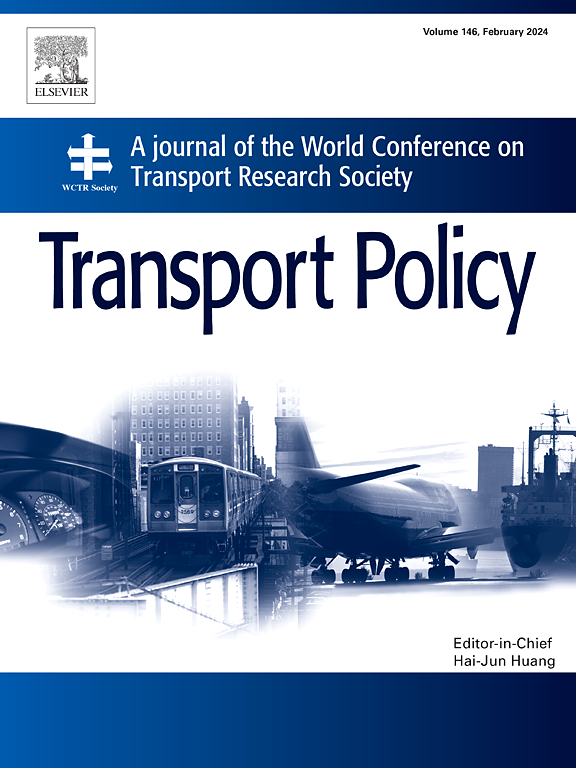Monitoring and evaluation of travel behaviour change in mobility-as-a-service (MaaS) trials: Insights from a longitudinal study
IF 6.3
2区 工程技术
Q1 ECONOMICS
引用次数: 0
Abstract
Travel behaviour change towards more sustainable modes of transport is required to achieve environmental sustainability. Mobility as a Service (MaaS) trials have been implemented in various cities over the past decade to reduce private car usage, and promote sustainability. Monitoring and evaluation (M&E) is a key component in developing MaaS trials, as it enables a comprehensive understanding and analysis of the MaaS's impact on modal shift. Although the insights from various MaaS trials have been explored in the literature, studies on the travel behaviour change M&E of these trials with longitudinal approaches were lacking. This paper proposes a M&E approach employing the Differences-in-Differences (DiD) method and incorporating three Key Performance Indicators (KPIs), to monitor and evaluate the travel behaviour change after the launch of the MaaS app. It uses longitudinal (baseline and recall) data to analyse the impact of MaaS on travel behaviour change for its users compared to non-users. The application of the proposed DiD-based M&E framework has been tested and validated on a real-world MaaS project with 887 MaaS users and 757 non-MaaS users. The results suggest that the private car use is reduced while public transport use increased for MaaS users, while for the non-MaaS users, the private car use is increased and public transport is decreased. Moreover, the DiD analysis showed that the impact of MaaS on the decrease in the private car and increase in public transport use is statistically significant. These findings and insights guide policymakers and transport practitioners in appraising the effectiveness of new MaaS systems, especially in car-dependent regions in the world.
移动即服务(MaaS)试验中出行行为变化的监测和评估:来自纵向研究的见解
为了实现环境的可持续性,需要改变旅行行为,转向更可持续的交通方式。在过去的十年里,移动即服务(MaaS)试点已经在多个城市实施,以减少私家车的使用,促进可持续发展。监测和评估(M&;E)是开发MaaS试验的关键组成部分,因为它可以全面了解和分析MaaS对模式转换的影响。虽然文献中已经探讨了各种MaaS试验的见解,但缺乏对这些试验的纵向方法的旅行行为改变M&;E的研究。本文提出了一种M&;E方法,采用差异中的差异(DiD)方法并结合三个关键绩效指标(kpi),来监测和评估MaaS应用程序启动后的旅行行为变化。它使用纵向(基线和召回)数据来分析MaaS对其用户的旅行行为变化的影响,与非用户相比。提出的基于did的M&;E框架的应用已经在一个有887个MaaS用户和757个非MaaS用户的实际MaaS项目中进行了测试和验证。结果表明:MaaS用户私家车使用量减少,公共交通工具使用量增加;非MaaS用户私家车使用量增加,公共交通工具使用量减少;此外,DiD分析表明,MaaS对私家车减少和公共交通使用增加的影响在统计上是显著的。这些发现和见解指导政策制定者和交通从业者评估新的MaaS系统的有效性,特别是在世界上依赖汽车的地区。
本文章由计算机程序翻译,如有差异,请以英文原文为准。
求助全文
约1分钟内获得全文
求助全文
来源期刊

Transport Policy
Multiple-
CiteScore
12.10
自引率
10.30%
发文量
282
期刊介绍:
Transport Policy is an international journal aimed at bridging the gap between theory and practice in transport. Its subject areas reflect the concerns of policymakers in government, industry, voluntary organisations and the public at large, providing independent, original and rigorous analysis to understand how policy decisions have been taken, monitor their effects, and suggest how they may be improved. The journal treats the transport sector comprehensively, and in the context of other sectors including energy, housing, industry and planning. All modes are covered: land, sea and air; road and rail; public and private; motorised and non-motorised; passenger and freight.
 求助内容:
求助内容: 应助结果提醒方式:
应助结果提醒方式:


